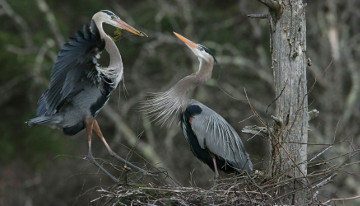Village News

PHOTO COURTESY OF GARRY KESSLER
In the “stick dance” display, a male great blue heron presents a pine twig to a female at the nest.
March 26, 2021, Page 6A
NATURE NOTES
By Annie Reid
Westborough Community Land Trust
Our annual dance of spring
You know it’s spring in March when our native great blue herons begin to return. These large wading birds, which feed mainly on fish, gradually return as open water appears in our icy ponds and swamps. It’s their breeding season, and they’re looking to nest in tall dead trees in standing water.
You might catch sight of a great blue heron (Ardea herodias) flying overhead, with its distinctively prehistoric look. Consider the sight a reminder that birds evolved from dinosaurs. The great blue heron wingspan is about 6 feet, fitting for a bird that stands 4 feet tall. Notice that these herons fly with their long legs trailing behind them and their long neck curled back (rather than outstretched as in many other long-necked birds).
Their stillness and gray-blue coloring makes great blue herons challenging to spot, but you’re most likely to find one along the shoreline of a pond or river. They hunt by sight, standing in shallow water and waiting for a fish to come near, or slowly stalking their prey. Using their straight, sharp bill either as a pincer or a spear, they capture prey in a lightning-fast strike. They swallow their catch whole, head-first. Great blue herons often return regularly to favorite fishing spots, so you might see one where you’ve seen it before.
Great blue herons are also creatures of habit when it comes to nesting. They nest in colonies, and many return year after year to the same location. That’s what they’re doing right now. Nesting colonies are often in out-of-the way places such as swamps and beaver ponds. The herons build stick nests high up – even 100 feet up – in dead trees surrounded by water, which keeps their eggs and chicks safe from land predators such as snakes and marauding raccoons. There may be two or three nests per tree. Returning herons might re-use last year’s nest or another one nearby.
The real excitement takes place as males and females court, pair up, and bond with various displays. The pairs that form may not be the same as in the previous year. Returning males claim nests and a bit of surrounding territory, and then returning females check out and choose nests.
One often-repeated display, sometimes informally known as the “stick dance,” is shown in the photo. The male selects a suitable stick from the woods (or another nest) and presents it to the female at the nest. She may respond with a “stretch” display, pointing her head and neck straight up. She then accepts the stick and works it into the nest. In another display, a great blue heron may fly slowly in circles around the nest, with neck outstretched.
After a nest is built or suitably refurbished, the female lays two to six eggs over several days, and both herons share incubation duty during the next 4 weeks. When the chicks hatch, the parents brood them for four weeks. First the male, and then both parents, work constantly to provide food for the chicks. In a lean year, the youngest chicks may not survive. As the chicks grow to adult size, they stand on the nest or a nearby branch, until they’re ready to fly at about seven to eight weeks old. By mid-July, the colony clears out.
For decades after its creation by damming in 1968, Westborough’s Mill Pond was home to a lively colony of great blue herons nesting in trees killed when the area was flooded. The tree branches finally gave out about 15 years ago, and the herons moved elsewhere. For years, there was even a shop named The Blue Heron at Westborough’s rotary.
Today few of us have front-row seats for watching great blue herons at their nests. Instead, you might have fun watching as other birds – such as house sparrows, which often nest in colonies near people – gather grass, stems, or twigs for nesting material and interact with mates, rivals, or recently fledged young.